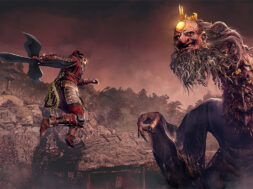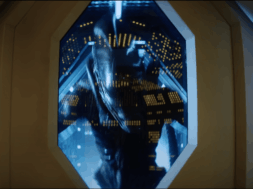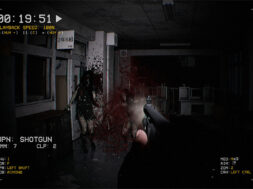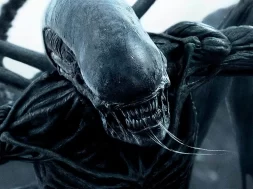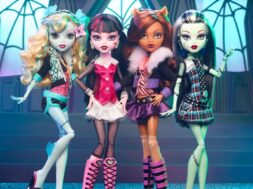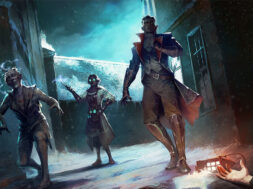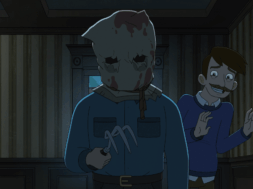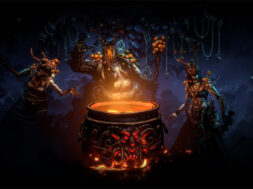We unpack the Echo Night trilogy of survival horror games and examine how they were able to bring deep, layered, emotional storytelling to the genre.
By the end of the 1990s, the survival horror genre was going strong and had found a real rhythm. Popular series like Resident Evil, Silent Hill, and Clock Tower were fully in swing and plenty of ambitious risks were being taken in the growing genre. In an area that is full of half-baked releases, it’s easy for some titles to fall into obscurity, but it’s especially a shame when those games are genuinely good. FromSoftware’s (who are now best known for the punishingly difficult Souls series) Echo Night debuted on the PlayStation in 1998 and went on to spawn a full trilogy. Echo Night is kind of like if Fatal Frame and Eternal Darkness had a baby. It’s a series of games that feature a strong combination of ambitious storytelling, a more intimate style of horror, and a repetitive, yet satisfying and enjoyable, gameplay setup. Echo Night may have been hiding in the shadows for decades, but now is the time to shine your flashlight on these impressive survival horror games.
Echo Night exhibits such a voice and style with a very sophisticated story and structure in place that’s a lot deeper than the standard survival horror experience. Its DNA is all over the place of the survival horror games of the early 2000s and it’s still one of the best survival horror series that deals with ghosts. The game is directed by Akinori Kaneko, who is someone that has other production credits in the video game industry, but has surprisingly only directed Echo Night and its sequel.
The basic story in Echo Night deals with a generational tale of demon possession as a son tries to solve a murder mystery that his father got involved in while trying to take down these demonic forces, without getting possessed himself. There’s also an important “evil” red knife that was used in a murder and continues to move down through generations and be used in ill deeds. This eventually even builds to a bit of an Infinity Gems kind of narrative where there’s a special “Soul Stone” that’s believed to have the power to change someone’s destiny and rewrite the past, but not without a significant sacrifice. Unfortunately, there’s no level set in Vormir.

Echo Night amounts to a fantastic puzzle-horror hybrid where the fear comes more from the story and the content rather than fighting against monsters. The gameplay here is first-person and much more puzzle-centric, but the puzzles are actually immensely satisfying, just challenging enough, and connect back to a super creepy story. At times it feels like a first-person horror RPG in the best way possible, right down to the graphic and design choices that are used. There’s also a major principle where ghosts can only go in the dark, so you need to turn on lights to keep them at bay (which becomes even more prominent in the sequel).
The game’s thrilling prologue is set on a train that has you in a tense gun standoff within ten minutes of playing the game. It lets you experience your ancestor’s history by actually playing it and moving you to new locations, which is so much more interesting than simply reading about it through old notes. It’s a very clever, effective structure to the game where you play as yourself, but also your father, to understand how big and connected this story really is.
Another major asset of Echo Night is that the game takes place throughout a boat, train, mine shafts, hotel, and other areas that are fairly atypical to a video game, let alone a horror title. These eclectic locations are due to the game’s “past-hopping” strategy, which not only works, but almost feels like a scarier, more lucid picture-jumping from Super Mario 64. It gets especially trippy when you’re jumping from one memory to even further in the past and operating on an Inception-level deepness from the main narrative as you move like a ghost through past events. It’s hard not to think of Eternal Darkness during these moments. Echo Night somewhat taps into the episodic horror feel of that game as you work through so many layers of this overarching mystery, especially when the importance of these brief flashbacks isn’t always obvious.

Echo Night knows how to create a freaky atmosphere and there are many sequences that stand out. There’s a merry-go-round section (which there aren’t enough of in video games) that’s quite unnerving, a scary blind shopkeeper character who has psychic abilities, and a casino detour where you need to play roulette, slot machine, and blackjack against a bunch of ghosts. There are plenty of jump scares with ghosts that are actually scary, too. There’s one scene where an old serial killer lures you into a dead-end in a cave so he can murder you and have his way with you, which is seriously upsetting. Even just the character models for humans look suspiciously alien and have an oddness to them, like they’re all porcelain dolls or something. The ghosts also have this shadowy appearance that goes a long way, too. It’s not intentional, but it does add to the overall creepy aesthetic of the game as well.
To further speak to the presentation of the game’s characters, they all have limited dialogue, but it comes out sounding rather stilted and scary in a way that’s really effective. It makes it seem more dream-like. The fact that the majority of these characters are all ghosts adds a certain cynical, lost nature to their dialogue, which is also great. For instance, there’s a character who sees the birth of a demon and completely loses his mind from it. It’s really oddly satisfying to give each of these ghosts closure and help them move on, but it’s also a very morose journey at times. Echo Night excels when it comes to putting together and posthumously telling a story. Giving these ghosts closure also translates to a principle where you’re collecting astral pieces, which is how you acquire the best ending in the game (of which there are many, which turns this into an even deeper game).
All three games in the Echo Night series received commendable reviews that range from average to good, but it’s the second game in the series, Echo Night 2: The Lord of Nightmares, that has the best critical reception of the lot. This makes it a particular shame that it’s the one title in the series to not come out in North America or Europe (although a fan translation has been released). Echo Night 2 is more or less a reimagining of the first game. It deals with the same themes and story and still stars “Richard Osmond, “yet this time it revolves around him trying to get answers behind the disappearance of his girlfriend, Christina. He begins to unwrap a mystery surrounding Christina’s past, her lineage, and her twin sister, Jessica. Once again the game deals with the sacred stone that murder sacrifices must be made to in order to have wishes granted. The sequel looks at a generational lust for immortality and the passing of the “Soul Stone” between ancestors.

Echo Night 2: The Lord of Nightmares adds to the premise by throwing a mysterious female character into the mix, who eggs Richard on throughout his journey. She seems to resent the fact that you’re helping give these ghosts closure and would prefer that you didn’t. It’s a nice development to add to the story and concept. She’s like the devil on all of these characters’ and ghosts’ shoulders as you try to be their angel. Along these lines, it’s satisfying to see how the game just takes the concepts of the original and further refines them, creates a more intricate story, and delivers a more polished overall presentation. There are fully spoken dialogue now, the graphics are such an improvement, and there are plenty more qualifiers to get an “S” in the end (it even catalogues all of the ghosts, like how Fatal Frame would later do). It’s just better in every way.
Echo Night 2 does a whole lot more with traveling back in time, but through the same locations, so it can have fun with how the same environments have differed and decayed over time. Along the same lines, the game gives the ghosts even deeper backstories and personalities this time around. You’re also returning a lot more lost relics to them, which makes the Astral Pieces process even more enjoyable. It almost makes it kind of feels like Super Mario 64 or some Rare collectathon game is mixed with a horror title (which is far from a bad thing). There are also simple, yet disturbing elements to the environments, like streaks of blood across the floor where a body has been dragged that linger and go far. The sequel generally has a more occult-y vibe, which the game doesn’t waste.
Echo Night 2 is full of unique scenes that are not the norm for a survival horror title. There’s a highly creative piano music composition puzzles, a game of hide-and-seek with a ghost girl, a waltz sequence and poker game between ghosts, and what’s by far the best blimp explosion you’ll see in a horror game. Some sections also incorporate water-based travel via a lazy boat as you move through passages in caves, which add a lot to the game’s eerie ambiance. The game’s epic showdown is set on the ascending steps of a clock tower that’s also a really strong way to finish. There’s also a pretty brilliant sequence where Albert ages from childhood to adulthood as he repeatedly leaves and enters a room. The game knows how to get in your head even more than its predecessor.
The third game in the series, Echo Night: Beyond, finally moves things over to the PlayStation 2. The game jumps forward all the way to the year 2044 and doesn’t hold back with its future-ness. Richard Osmond is on his way to the freaking moon, when the mission crashes and he’s the soul survivor. At this point, while there was variety present in terms of the monsters that populated survival horror games, the environments that they’re set in were still stagnant to some degree. Some titles, like Dino Crisis and Deep Fear, tried to get creative with their locations, but during the late ‘90s and early 2000s, outer space was still a relatively untapped area for the survival horror genre (although shooters had done plenty with it). The concept of ghosts on the moon may seem crazy, but it actually “makes sense” with all of the crashes and disasters that could happen out there.

Since it’s set on the moon, things are drastically different than before, but Echo Night: Beyond retains the “can only get hurt in the dark” aspect and equips Richard with a flashlight. In fact, it really feels like a prototype to Alien: Isolation in many ways (as well as Silent Hill: The Room in terms of how it creates some of its scares). In spite of its differences, it’s still a solid game, much like the others, and it ends the trilogy on a strong note. It’s also decidedly more frightening and stressful than the previous two Echo Night titles and it embraces the horror of its title as opposed to the more investigative aspects that drive the previous games. Right from the start, it attacks, and not just with ghosts, but unstable debris and malfunctioning robots instantly create a tense atmosphere and the game knows where to insert the right jump scares. There’s an incredible amount of tension when you have to run through a dark hallway to get through to a new room, knowing you’re susceptible to ghosts during that short time.
Much like how the previous titles were innovative for their time, Echo Night: Beyond also incorporates some creative, new features, like a degree of weightlessness to areas and a heart rate monitor where Richard’s pulse will increase when ghosts are nearby or something is about to strike. There are also some effective scenes and scares that play out through security camera footage, which also becomes a dominant gameplay mechanic. A compelling murder mystery that revolves around the red stone also plays out across the collected security camera footage, which is a clever way to tell this narrative that’s independent of Richard.
Another great idea involves the front of Richard’s space helmet getting fogged up with ghost handprints that obstruct your view and take some time to dissipate. It’s a great creepy touch that couldn’t be possible in the other games. On top of all of those physical fears, this is just a much more sterile and isolating experience than the previous two games, which does also play into the fear factor. There are some limited segments where you do venture out of the shuttle and actually brave the terrain of planets on the outside of the ship, which carry a lot of suspense to them as well.
Curiously, as much as Echo Night: Beyond changes and “updates” the game, it truly keeps it the same and retains the core ghost saving and “using light as a weapon” aspect of the original games (but ditches the jumping back in time aspect). Then it just makes it scarier. It’s a surprisingly satisfying updated sequel, whereas a lot of titles crashed and burned when they tried to make the transition over to this gaming generation, especially survival horror games.
Echo Night delivered three consistent survival horror games that helped contribute to the genre. This isn’t necessarily a series that needs to be revived since Fatal Frame is largely doing a lot of the same stuff and in more effective ways, plus FromSoftware has definitely moved onto greener pastures. That being said, it’s still unfortunate that these games are so unknown and that Echo Night 2 never had a real localized release. Remastering the trilogy (or even just the first two games) so new people can appreciate this piece of survival horror gaming history would be nice. The original game was added to the PlayStation Network in 2015 (albeit eight years after the Japanese store had it), but these titles could still be made more accessible. Richard Osmond and his ghostbusting ways deserve more exposure.

